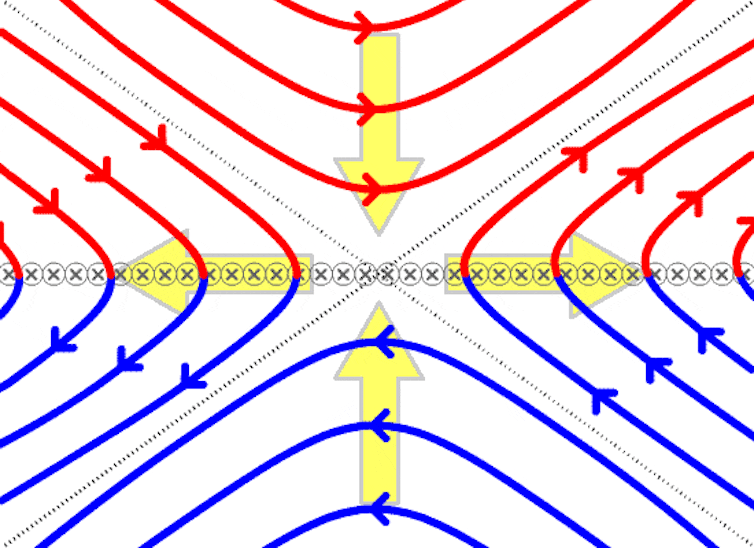Research is an unpredictable process. Sometimes you end up making a really cool discovery that you didn’t see coming. I recently uncovered a fundamental property of lightsabers (that’s right – the awesome weapons from Star Wars) while doing my regular plasma physics research. I found that, while it is in theory possible to build a lightsaber, it’s likely it would be the most dangerous weapon ever created – both for the perpetrator and the victim.
With Star Wars: The Force Awakens being released on DVD after breaking all kinds of records at the box office, I figured it was a good time to share the news.
Despite the name, it has been established in Star Wars canon that these ancient weapons of the Jedi are, in fact, not laser swords but blades of plasma. Plasma is often known as the “fourth state of matter” in addition to the solids, liquid and gases that we’re all familiar with here on Earth. However, plasmas are by far the most common state of all visible matter in the universe (excluding the mysterious “dark matter” or “dark energy”) comprising some 99%.
The thing that makes plasmas different from the other states is that they are composed of electrically charged particles – loose electrons (negatively charged) and atoms that have lost electrons (positively charged), despite having no overall charge. Any moving electric charge, such as those inside a plasma, creates magnetic fields and can also be manipulated using magnetic or electric fields – unlike a neutral gas.
Magnetic fields are the key to containing the plasma in a blade, they can counteract the pressure of the hot plasma trying to expand into its surroundings. This is exactly one of the approaches that have been developed in trying to harness nuclear fusion power, in which atomic nuclei (atoms that have no electrons) collide to form a new nucleus while releasing huge amounts of energy.

Fusion requires incredible temperatures so that the positively charged atomic nucleii can overcome their tendency to repel each other. We create these hot plasmas in doughnut-shaped fusion reactors (“tokamaks”) which use strong electromagnets in the reactor walls to keep this plasma at bay. The largest of these such experimental reactors will be ITER (International Thermonuclear Experimental Reactor) construction of which will finish in 2019 and which aims to finally be able to produce more energy via fusion than is put in to create, sustain and control the plasma itself.
Mysterious glow
There are two ways plasmas can emit light. The first is by being incredibly hot. The sun, for instance, is a ball of hot plasmas whose heat source comes from the fusion taking place in its core. All hot objects emit electromagnetic radiation with specific wavelengths. Their perceived colour depends solely on their temperature, going from red for lower temperatures and blue for higher temperatures. This is likely the source of a lightsaber’s glow – if you want a really dangerous lightsaber, you need a blue one.
The other way plasmas may glow is very similar to how a fluorescent bulb works. By running an electrical current through a plasma, electrons can collide with the positively-charged atoms (dubbed ions), which raises their energy. It’s similar to picking up a ball off the ground and putting it on one of many shelves – this raises the ball’s potential energy, whereby the shelves represent the energy levels of the ions. But nature is inherently lazy and will always strive to go back to the lowest possible state of energy. Eventually the ball will roll off of the shelf falling back to the ground. The ions do this by releasing their excess energy as light – which could create the lightsaber glow. This light will be of a specific colour depending on the composition of the plasma.
While lightsabers do seem feasible from a physics point of view, the power requirements for such a device would be immense, especially given that it needs to be contained within the small lightsaber hilt. Huge advances in technology would be required to make lightsabers a reality. But there’s an even bigger problem which would come about if you were to ever have a lightsaber duel like in the movies.
Powerful magnetic effects
Magnetic reconnection is a fundamental plasma physics process which can occur when plasmas with different magnetic fields collide. As the magnetic fields of each plasma get close to each other, the entire pattern of magnetic field lines changes and everything realigns into a new magnetic configuration – releasing huge amounts of energy.

This is what essentially fuels the aurora or northern lights – energy from the solar wind is released when these particles collide with plasma inside Earth’s magnetic field under a specific set of conditions.
It’s from our studies of the conditions under which reconnection can occur in space that I was able to realise the problem with lightsaber battles. When two plasma blades clash it is almost impossible to avoid magnetic reconnection, with the results being an explosive release of the plasma contained in both sabers. This would mean that, if you were in a lightsaber duel, both you and your opponent would have body parts vaporised in a single clash!
Perhaps the makers of the coming two Star Wars films should make a note … then again who knows how “The Force” really works?

